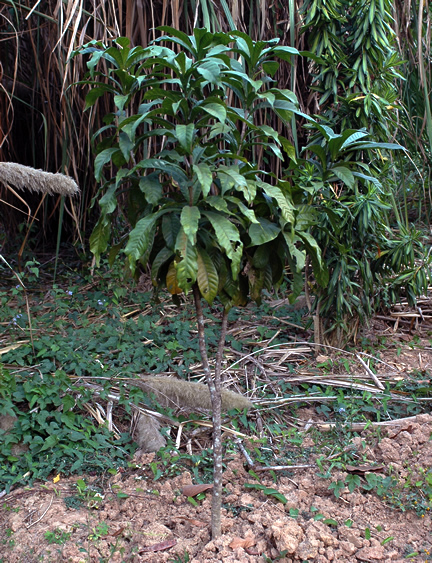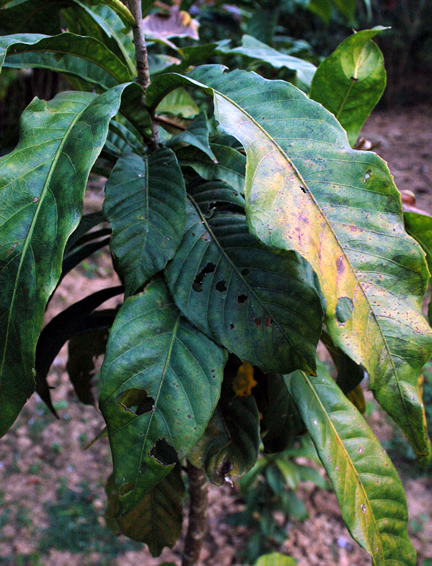
Tropicals, Woody > Gustavia > Gustavia superba > Gustavia superba
Gustavia superba
Membrillo, Heaven Lotus
Origin: Panama, Costa Rica and Northern Colombia.
| Family |
| Lecythidaceae |
| Genus |
| Gustavia |
| Species |
| superba |
| Category |
| Tropicals, Woody |
| Type |
| Tree (deciduous) |
| USDA Hardiness Zone |
| 11 - 13 |
| Canadian Hardiness Zone |
| cool season protection under glass. |
| RHS Hardiness Zone |
| H1a - H1c |
| Temperature (°C) |
| 4 - 21 |
| Temperature (°F) |
| 40 - 70 |
| Height |
| 6 - 15 m |
| Spread |
| 3 m |
Photographs
Description and Growing Information
Flowering Period
| General Description |
| A small tropical tree that draws attention with its large unique blooms. |
| Landscape |
| Can be grown as a small tree or shrub, as a specimen or in a large container. |
| Cultivation |
| Requires a moist, humid environment with an appropriate amount of heat and sunlight. |
| Growth |
| Slow |
| ID Characteristic |
| Huge leaves. Bark can be scratched to reveal the unpleasant odour of the tree – sometimes referred to as stinkwood. |
| Pests |
| Iguanas eat the leaves of plant. May be susceptible to thrips. |
| Bark/Stem Description |
| Bark is light in colour with no prominent ridges. Appears to be smooth with no visible lenticils or rough texture. |
| Flower/Leaf Bud Description |
| Buds are around 10 - 15 cm in size in a semicircle shape. |
| Leaf Description |
| One large cluster of leaves per branch; looks very similar to palms with its large leaf size. Leaves are simple and arranged in an alternate pattern on short petioles. Leaf shape is oblanceolate with the base being much thinner than the apex. Edges are serrate. Pronounced venation on underside of leaves creates slight indentations on upper side where veins occur. Leaves have a general appearance of drooping downwards. |
| Flower Description |
| Flowers that grow directly off woody branches. They span from 10 - 15 cm with 6 - 9 petals. Stamens curl inwards around the centre of the flower. Sepals are not visible. The flowers are arranged in a corymb form; pedicils vary in length creating a flat head of multiple flowers. |
| Fruit Description |
| Fruit are called chupa, are round in shape and are 10 - 16 cm in size. They have a somewhat flattened bottom. The inside of the fruit is a yellow flesh that Natives compare to avocado. There are around 2 - 20 seeds per fruit. The seeds are relatively large and measure around 3 - 4 cm. It is a pyxidium seed that opens at the top when it is ready to release its seeds. |
| Colour Description |
| Immature leaves are reddish-brown, but eventually turn a glossy dark green colour when mature. The blooms are a white-cream colour with light pink through, but located mostly around the edges of flower petals. The fruit is green and brown in colour and has an orange fleshy centre. The bark is a neutral grey-brown colour. |
| Texture Description |
| Medium. |
| Notable Specimens |
| Fairchild Tropical Botanic Garden, Miami, Florida, United States of America. Singapore Botanic Gardens, Singapore. |
| Propagation |
| By seed. |
| Ethnobotanical Uses (Disclaimer) |
| Pulp of fruit eaten regularly by the Choco Indians; grown for consumption in the countries of origin. Fruit can be consumed cooked or raw. A decoction of the leaves are used on poison arrows. The wood is sometimes used for construction. |
References
Croat, T. (1978) Flora of Barro Colorado Island. United States: Stanford University Press.
Mori, S., & Kallunki, J. (1976). Phenology and Floral Biology of Gustavia superba ​(Lecythidaceae) in Central Panama. Biotropica, 8(3), 184-192. doi: 10.2307/2989684

